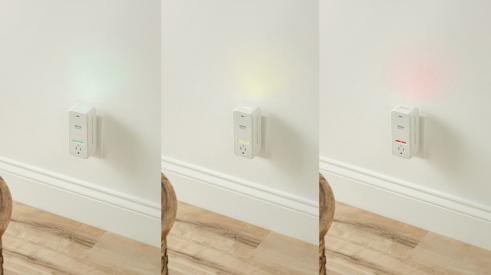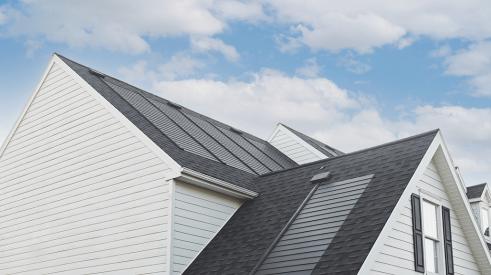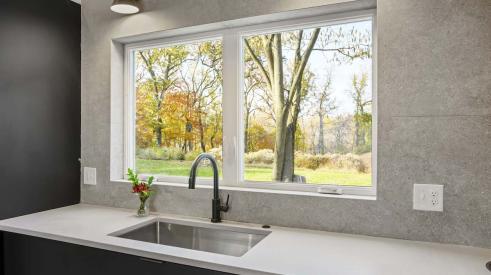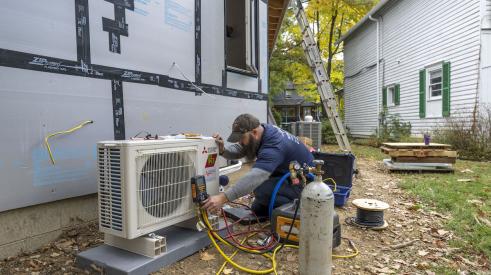As energy prices continue their upward climb, homeowners are looking for ways to keep those costs under control. Professional remodelers can help by making energy-saving home improvements. But first an energy audit must be done to find where energy is being wasted now and where it can be saved. This is a value added service remodelers can offer, with the goal of following up each audit by completing the needed home improvement work.
What is an energy audit?
A home energy audit is a whole-home assessment to determine how much energy a home consumes and to identify problem areas, explains Leslie McDowell, director of marketing and communications for the Building Performance Institute Inc. (BPI), Malta, N.Y. Auditors begin by interviewing the homeowner to learn which symptoms they have noticed in the home and what, if anything, has been done to try to fix those symptoms. The auditor will also evaluate several months of energy bills.
BPI CERTIFICATION
BPI certification gives homeowners the assurance energy auditors know what they are doing. BPI offers 11 different professional certifications, with Building Analyst being the most popular choice for energy auditors. Those who pass the Building Analyst written and field exams will have knowledge of the fundamentals of building science and the knowledge, skills, and abilities needed to perform comprehensive, whole-home assessments. Passing these exams show they can correctly use diagnostic equipment including a blower door and infrared camera to evaluate energy leaks and usage, can perform combustion appliance back-draft safety tests, can prepare prioritized analysis reports, and can make appropriate recommendations for energy improvements.
As a certifying body, BPI cannot offer courses itself, so it works with more than 200 independent testing centers nationwide at community colleges and private and non-profit training organizations that provide the training needed to complete the exams successfully. Each testing center sets its own price for training and exams. There are no educational or work experience prerequisites to become a BPI-certified Building Analyst. Certifications are good for three years to ensure those certified remain current with changing building science best practices. They can be renewed by repassing the exams or by earning 30 continuing education units and demonstrating 3,000 hours of relevant work experience.
“BPI certified professionals will conduct a thorough walk-through, both indoors and out,” McDowell says. “They use an infrared camera to get a visual on temperature differences in different areas; conduct a blower door test to depressurize the house and assess air leakage levels throughout the building envelope; and test for leakage in the duct work of forced-air HVAC systems. They will also perform other function and safety tests on HVAC and other appliances, including carbon monoxide levels and combustion appliance back-draft testing.”
Once the audit is complete, the auditor will provide an audit report prioritizing repairs in the proper order from must-do to nice-to-do. This way, the biggest problems will be solved without making smaller problems worse. After the home performance improvement work is completed, the auditor will conduct a second whole-home assessment to make sure all the corrections work and the desired performance levels have been achieved.
“Many homeowners believe the cause of home performance problems—such as drafty rooms, cold or hot rooms, or moisture problems—come from a single source, such as bad windows or an old HVAC system,” McDowell says. “BPI certified pros are trained to evaluate the whole house as a system. They understand the relationship between the building envelope, heating and A/C system, insulation, mechanical ventilation, lighting, and appliances. The house really is a system of interconnected components. Solving home performance problems means looking at how these components function together to reveal the most complete and cost efficient solutions for the homeowner.”
It’s not just about the audit
While the energy audit is a necessary first step, just knowing what is wrong solves nothing. Homeowners need to follow up by hiring a home performance contractor to make needed improvements. That contractor can and probably should be the same person who did the audit.
The U.S. Department Of energy Home Energy Score
In a research-based effort to provide homeowners and potential homeowners with information on homes’ energy efficiency, the U.S. Department of Energy (DOE) has developed the Home Energy Score. Similar to vehicle miles-per-gallon ratings, it is a method for assessing the energy performance of a home’s major energy systems and envelope, explains Home Energy Score Program Manager Joan Glickman.
“You’re getting a quick, low-cost assessment using standard methods,” Glickman says. “Remodelers, eventually, could use it while doing a remodel to demonstrate to a homeowner the value of adding insulation or sealing ducts to improve the home’s efficiency.” Introduced in 2012 and recently updated, it ranks homes on a 10-point scale with homes scoring “10” expected to use the least energy.
Qualified assessors must meet certain requirements, like being BPI or RESNET certified, before taking a free online training module and passing a free online test. Assessors visit each home to gather information about its foundation, roof, windows, heating, cooling, hot water, ducts, and insulation.
The data is entered online using the Energy Score tool developed by DOE and Lawrence Berkeley National Laboratory. This generates a Home Energy Score report with the home’s current rating and its potential rating after home performance improvements are made, with recommendations of the most cost-effective improvements and how much money they will save. Unlike a home energy audit, the Home Energy Score is based only on observation, can be completed in less than an hour, and requires no diagnostic testing.
Qualified assessors work under partners including utility companies and state and local governments. Partners must perform periodic assurance checks on at least 5 percent of homes scored by their assessors. Glickman says DOE will soon add national partners so Home Energy Scores will be available nationwide. For more information, visit www.homeenergyscore.gov.
TerraLogos Energy Group, Baltimore, started as an energy auditor in 2006. Peter Van Buren, director of marketing and sales, says they quickly learned it didn’t work to expect homeowners to make their own arrangements for hiring contractors, so they added contracting services in 2007.
“You need to have the same person diagnosing it and doing the work to get the most effective results and get them for the least cost,” Van Buren says. “The remodeler won’t understand the solution if he doesn’t understand the problem. All of the different systems in the house work together as one unit to get the performance, comfort, safety, and energy use of the house. If any one is out of sync or not functioning properly, money will be wasted.”
 Liability is another concern in the event something goes wrong and the home performance improvements don’t produce the desired results or, worse, make the house unsafe.
Liability is another concern in the event something goes wrong and the home performance improvements don’t produce the desired results or, worse, make the house unsafe.
Who is responsible if different companies did the audit and the improvement work?
Neil Kelly Co., Portland, Ore., got into energy work the other way, starting as a contractor in 1947 and adding a home performance division in 2006. It has been successful, going from $250,000 in 2008 with two employees to $8 million in 2013 with a staff of 65, and generating about one-third of the company’s business. Chad Ruhoff, home performance manager for Neil Kelly Co., sees remodelers as the best group to get involved in energy audits and home performance contracting.
“Remodelers already deal with electricians, plumbers, and HVAC,” Ruhoff says. “They understand how the systems in a home work with each other. They’re the right people to do that work. It’s not easy work and a little bit different than normal remodeling. Consumers have different expectations. It’s more about function than form. The jobs are comparatively small compared to remodels so you end up doing a lot more in a year to get the same revenue. Despite that, it’s a great add-on business for a remodeler.”
The home performance staff does only that type of work. Any additional remodeling business these activities generate is passed on to Neil Kelly’s remodeling division. The challenge is persuading the home-energy audit customer of the benefits of doing possibly costly home performance improvements. If homeowners choose to finance their improvements, their loan payments are often lower than the amount they save on their energy bills. This means their monthly out-of-pocket will be about the same as what they are spending now.
Michele Knaszak, vice president of GreenHomes America, Irvine, Calif., says many contractors close as many as 40-to-50 percent of those who hire them for audits.
Neil Kelly has developed a technique to boost the closure rate. They use teams consisting of an energy auditor and a salesperson, both BPI certified, to do each home audit. This lets the auditor, who is often an engineer, concentrate on studying the home’s features while the salesperson answers the homeowner’s questions and explains what the auditor is doing.
The salesperson then drafts the design for the home performance work to meet the homeowner’s goals. After adopting this team audit procedure, Neil Kelly’s close rates for getting the home performance contract went through the roof.
“We found out homeowners don’t buy what they don’t understand,” Ruhoff says.
Before construction begins, the salesperson and the project manager visit the homeowner to explain how construction will proceed, with the project manager taking over communication at that point so the salesperson is available to make more sales.
Which homes will benefit?
“We almost never come across a house that wouldn’t benefit from energy improvements,” Van Buren says. How much energy can be saved depends on the age of the home and how it is constructed. The normal range is 20-to-40 percent. Big improvements will be seen in anything built before 1990. Homes built after 2000 can be improved as well, but this will usually be expensive. That means the payback in energy efficiency is less than in an older home, although residents should experience major paybacks in comfort.
The most common upgrades Van Buren sees include air sealing with effective insulation upgrades, duct sealing, correcting moisture issues, and making sure all equipment has been properly installed and sized right for the home. Ruhoff generally agrees, listing correcting insulation levels, air sealing, replacing windows, replacing heating and cooling systems, ventilation, and moisture removal as what they most often improve.
“Most consumers come to us looking for energy savings but they end up purchasing on comfort and health and safety aspects. After we’ve done our tests, energy savings end up being a bonus,” Ruhoff says.
Clients say their energy savings have been more than 60 percent.
Getting started
Thinking of adding home energy auditing and home performance contracting to your remodeling business? To get started, Ruhoff recommends attending the national conference of the non-profit professional association Affordable Comfort Inc. After deciding to pursue business opportunities in home performance contracting, he says remodelers first must obtain BPI certification.
They will also need to make a capital investment in a blower door, an infrared camera, and a combustion appliance analyzer to do energy audits. For help in finding clients and getting their jobs financed, hook up with local programs in your area that support energy efficiency like Clean Energy Works Oregon.
Getting connected to Home Performance with Energy Star contractors and programs, utility companies, and government agencies in your area already involved in energy and home performance is important, Van Buren says. He also suggests joining the national trade organization Efficiency First. Both associations provide free online webinars on how to get into the business and other useful resources.
Remodelers who are hesitant about starting out on their own in home performance contracting may find it beneficial to join a franchise network. Contractors who are part of the GreenHomes America franchise network have “a strong ethical culture embedded in all aspects of the business.” GreenHomes America offers its partners comprehensive continuing training for everyone on the remodeler’s staff. This training includes all aspects of the home performance contracting business such as BPI certification training, marketing, lead generation, technical training, sales, installation techniques, safety, testing out, job processing, material purchasing, and even how to assist homeowners in obtaining financing, Knaszak says.
Ongoing support helps franchisees deal with questions as they develop. Franchise cost depends on the specific needs of the potential franchisee and the number of territories purchased. Territories usually include 100,000 homes and may be exclusive.
What do your remodeling clients say to you about their energy concerns?
Maybe it’s time to add energy audits and home performance contracting to your business. PR
Energy audits can be a potential profit center for remodelers.
Add new comment
Related Stories
Working Toward Affordable, Resilient Homes
A new natural disaster protection act from NAHB aims to support hazard mitigation projects
Client Design Choices in the Time of Social Media and AI
Social media speeds up the trend cycles, and now artificially created images are falling into homeowners' hands
Indoor Air Quality Gets Smart
A home's air quality can now be cloud connected and fully automated with this innovative product
Webinar: From Disjointed Design to Cohesive and Efficient—The New American Remodel 2023
Access the recording for the first The New American Remodel webinar held on March 8 at 2 pm CT
5 Standout Energy-Efficient Products Spotted at IBS 2023
See what this green remodeler recommends from the show floor
Innovative Products: GAF Energy Timberline Solar Shingles
GAF Energy’s latest innovation has taken the solar world by storm
Detailed Design: Benefits of Biophilism
See the details our Model ReModel contractors chose to infuse nature into their ADU
Heat Pumps Now Required in Washington New Construction
Washington is the second state to require heat pumps in an effort to electrify homes











